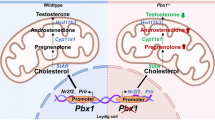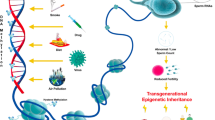Abstract
Histone H3 lysine 4 methylation (H3K4me) is an epigenetic modification associated with gene activation and is dynamically regulated by histone methylases and demethylases. To date, the expression patterns of H3K4me and its demethylases in the developing testis remain unclear. The present study was designed to detect the expression of H3K4me1/2/3 and its demethylases LSD1, RBP2 and SMCX in 21-, 40- and 60-day-old mouse testes by using immunohistochemistry, quantitative real-time polymerase chain reaction (PCR) and Western blot. The immunohistochemical results demonstrated that the expression patterns of the same protein were similar in testes at different ages and that the positive staining cell types were mainly Leydig cells, type A and B spermatogonia, leptotene spermatocytes and spermatids for H3K4me1/2/3, Leydig cells, type A spermatogonia, zygotene and pachytene spermatocytes, spermatids, and Sertoli cells for LSD1 and type A and B spermatogonia for RBP2. Immunostaining for SMCX was not detected in testes. Quantitative real-time PCR and Western blot showed that the amounts of LSD1, RPB2 and SMCX mRNA and protein were age-dependent, were significantly reduced with increasing age and exhibited a negative correlation with the protein levels of H3K4me1/2/3. Thus, H3K4me, which is modified by its demethylases, probably plays a role in male spermatogenesis and testis development.



Similar content being viewed by others
References
Akimoto C, Kitagawa H, Matsumoto T, Kato S (2008) Spermatogenesis-specific association of SMCY and MSH5. Genes Cells 13:623–633
Auharek SA, de França LR (2010) Postnatal testis development, Sertoli cell proliferation and number of different spermatogonial types in C57BL/6J mice made transiently hypo- and hyperthyroidic during the neonatal period. J Anat 216:577–588
Benton L, Shan LX, Hardy MP (1995) Differentiation of adult Leydig cells. J Steroid Biochem Mol Biol 53:61–68
Cannistra SA (2004) Cancer of the ovary. N Engl J Med 351:2519–2529
Christensen J, Agger K, Cloos PA, Pasini D, Rose S, Sennels L, Rappsilber J, Hansen KH, Salcini AE, Helin K (2007) RBP2 belongs to a family of demethylases, specific for tri- and dimethylated lysine 4 on histone 3. Cell 128:1063–1076
Glaser S, Schaft J, Lubitz S, Vintersten K, van der Hoeven F, Tufteland KR, Aasland R, Anastassiadis K, Ang SL, Stewart AF (2006) Multiple epigenetic maintenance factors implicated by the loss of Mll2 in mouse development. Development 133:1423–1432
Glaser S, Lubitz S, Loveland KL, Ohbo K, Robb L, Schwenk F, Seibler J, Roellig D, Kranz A, Anastassiadis K, Stewart AF (2009) The histone 3 lysine 4 methyltransferase, Mll2, is only required briefly in development and spermatogenesis. Epigenetics Chromatin 2:5
Godmann M, Auger V, Ferraroni-Aguiar V, Di Sauro A, Sette C, Behr R, Kimmins S (2007) Dynamic regulation of histone H3 methylation at lysine 4 in mammalian spermatogenesis. Biol Reprod 77:754–764
Grimaldi P, Pucci M, Di Siena S, Di Giacomo D, Pirazzi V, Geremia R, Maccarrone M (2012) The faah gene is the first direct target of estrogen in the testis: role of histone demethylase LSD1. Cell Mol Life Sci 69:4177–4190
Griswold MD (1998) The central role of Sertoli cells in spermatogenesis. Semin Cell Dev Biol 9:411–416
Iwase S, Lan F, Bayliss P, de la Torre-Ubieta L, Huarte M, Qi HH, Whetstine JR, Bonni A, Roberts TM, Shi Y (2007) The X-linked mental retardation gene SMCX/JARID1C defines a family of histone H3 lysine 4 demethylases. Cell 128:1077–1088
Jenuwein T, Allis CD (2001) Translating the histone code. Science 293:1074–1080
Jeyaraj DA, Grossman G, Weaver C, Petrusz P (2002) Dynamics of testicular germ cell proliferation in normal mice and transgenic mice overexpressing rat androgen-binding protein: a flow cytometric evaluation. Biol Reprod 66:877–885
Katz DJ, Edwards TM, Reinke V, Kelly WG (2009) A C. elegans LSD1 demethylase contributes to germline immortality by reprogramming epigenetic memory. Cell 137:308–320
Kleene KC (1989) Poly(A) shortening accompanies the activation of translation of five mRNAs during spermiogenesis in the mouse. Development 106:367–373
Klose RJ, Yan Q, Tothova Z, Yamane K, Erdjument-Bromage H, Tempst P, Gilliland DG, Zhang Y, Kaelin WG Jr (2007) The retinoblastoma binding protein RBP2 is an H3K4 demethylase. Cell 128:889–900
Konovalov S, Garcia-Bassets I (2013) Analysis of the levels of lysine-specific demethylase 1 (LSD1) mRNA in human ovarian tumors and the effects of chemical LSD1 inhibitors in ovarian cancer cell lines. J Ovarian Res 6:75
Kouzarides T (2007) Chromatin modifications and their function. Cell 128:693–705
Lan F, Nottke AC, Shi Y (2008) Mechanisms involved in the regulation of histone lysine demethylases. Curr Opin Cell Biol 20:316–325
Lee MG, Norman J, Shilatifard A, Shiekhattar R (2007) Physical and functional association of a trimethyl H3K4 demethylase and Ring6a/MBLR, a polycomb-like protein. Cell 128:877–887
Livak KJ, Schmittgen TD (2001) Analysis of relative gene expression data using real-time quantitative PCR and the 2(−Delta Delta C(T)) method. Methods 25:402–408
Madsen B, Spencer-Dene B, Poulsom R, Hall D, Lu PJ, Scott K, Shaw AT, Burchell JM, Freemont P, Taylor-Papadimitriou J (2002) Characterisation and developmental expression of mouse Plu-1, a homologue of a human nuclear protein (PLU-1) which is specifically up-regulated in breast cancer. Gene Expr Patterns 2:275–282
Madsen B, Tarsounas M, Burchell JM, Hall D, Poulsom R, Taylor-Papadimitriou J (2003) PLU-1, a transcriptional repressor and putative testis-cancer antigen, has a specific expression and localisation pattern during meiosis. Chromosoma 112:124–132
Matzkin ME, Yamashita S, Ascoli M (2013) The ERK1/2 pathway regulates testosterone synthesis by coordinately regulating the expression of steroidogenic genes in Leydig cells. Mol Cell Endocrinol 370:130–137
Meng F, Sun G, Zhong M, Yu Y, Brewer MA (2013) Inhibition of DNA methyltransferases, histone deacetylases and lysine-specific demethylase-1 suppresses the tumorigenicity of the ovarian cancer ascites cell line SKOV3. Int J Oncol 43:495–502
Metzger E, Wissmann M, Yin N, Müller JM, Schneider R, Peters AH, Günther T, Buettner R, Schüle R (2005) LSD1 demethylates repressive histone marks to promote androgen-receptor-dependent transcription. Nature 437:436–439
Morales A (2011) Androgens are fundamental in the maintenance of male sexual health. Curr Urol Rep 12:453–460
Sato T, Matsumoto T, Yamada T, Watanabe T, Kawano H, Kato S (2003) Late onset of obesity in male androgen receptor-deficient (AR KO) mice. Biochem Biophys Res Commun 300:167–171
Schaner CE, Deshpande G, Schedl PD, Kelly WG (2003) A conserved chromatin architecture marks and maintains the restricted germ cell lineage in worms and flies. Dev Cell 5:747–757
Shao GB, Ding HM, Gong AH (2008) Role of histone methylation in zygotic genome activation in the preimplantation mouse embryo. In Vitro Cell Dev Biol Anim 44:115–120
Sharpe RM, Maddocks S, Millar M, Kerr JB, Saunders PT, McKinnell C (1992) Testosterone and spermatogenesis. Identification of stage-specific, androgen-regulated proteins secreted by adult rat seminiferous tubules. J Androl 13:172–184
Shi Y, Lan F, Matson C, Mulligan P, Whetstine JR, Cole PA, Casero RA, Shi Y (2004) Histone demethylation mediated by the nuclear amine oxidase homolog LSD1. Cell 119:941–953
Xiang Y, Zhu Z, Han G, Ye X, Xu B, Peng Z, Ma Y, Yu Y, Lin H, Chen AP, Chen CD (2007) JARID1B is a histone H3 lysine 4 demethylase up-regulated in prostate cancer. Proc Natl Acad Sci U S A 104:19226–19231
Xiao Y, Bedet C, Robert VJ, Simonet T, Dunkelbarger S, Rakotomalala C, Soete G, Korswagen HC, Strome S, Palladino F (2011) Caenorhabditis elegans chromatin-associated proteins SET-2 and ASH-2 are differentially required for histone H3 Lys 4 methylation in embryos and adult germ cells. Proc Natl Acad Sci U S A 108:8305–8310
Yamane K, Tateishi K, Klose RJ, Fang J, Fabrizio LA, Erdjument-Bromage H, Taylor-Papadimitriou J, Tempst P, Zhang Y (2007) PLU-1 is an H3K4 demethylase involved in transcriptional repression and breast cancer cell proliferation. Mol Cell 25:801–812
Acknowledgments
The authors are grateful to the editors and reviewers for their helpful comments.
Author information
Authors and Affiliations
Corresponding author
Additional information
This study was supported by grants from the National Natural Science Foundation of China (nos. 81170573, 31372407), Henan Key Science and Technology Foundation (no. 132102110118) and Senior Personnel Program of Jiangsu University (no. 12JDG063).
The authors have no conflict of interest to declare.
Rights and permissions
About this article
Cite this article
Zhang, L., Wang, J., Pan, Y. et al. Expression of histone H3 lysine 4 methylation and its demethylases in the developing mouse testis. Cell Tissue Res 358, 875–883 (2014). https://doi.org/10.1007/s00441-014-1991-9
Received:
Accepted:
Published:
Issue Date:
DOI: https://doi.org/10.1007/s00441-014-1991-9




